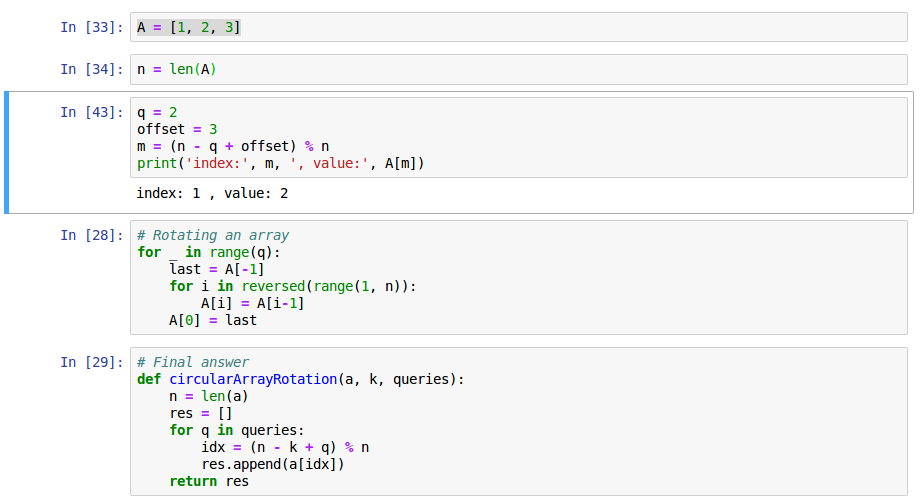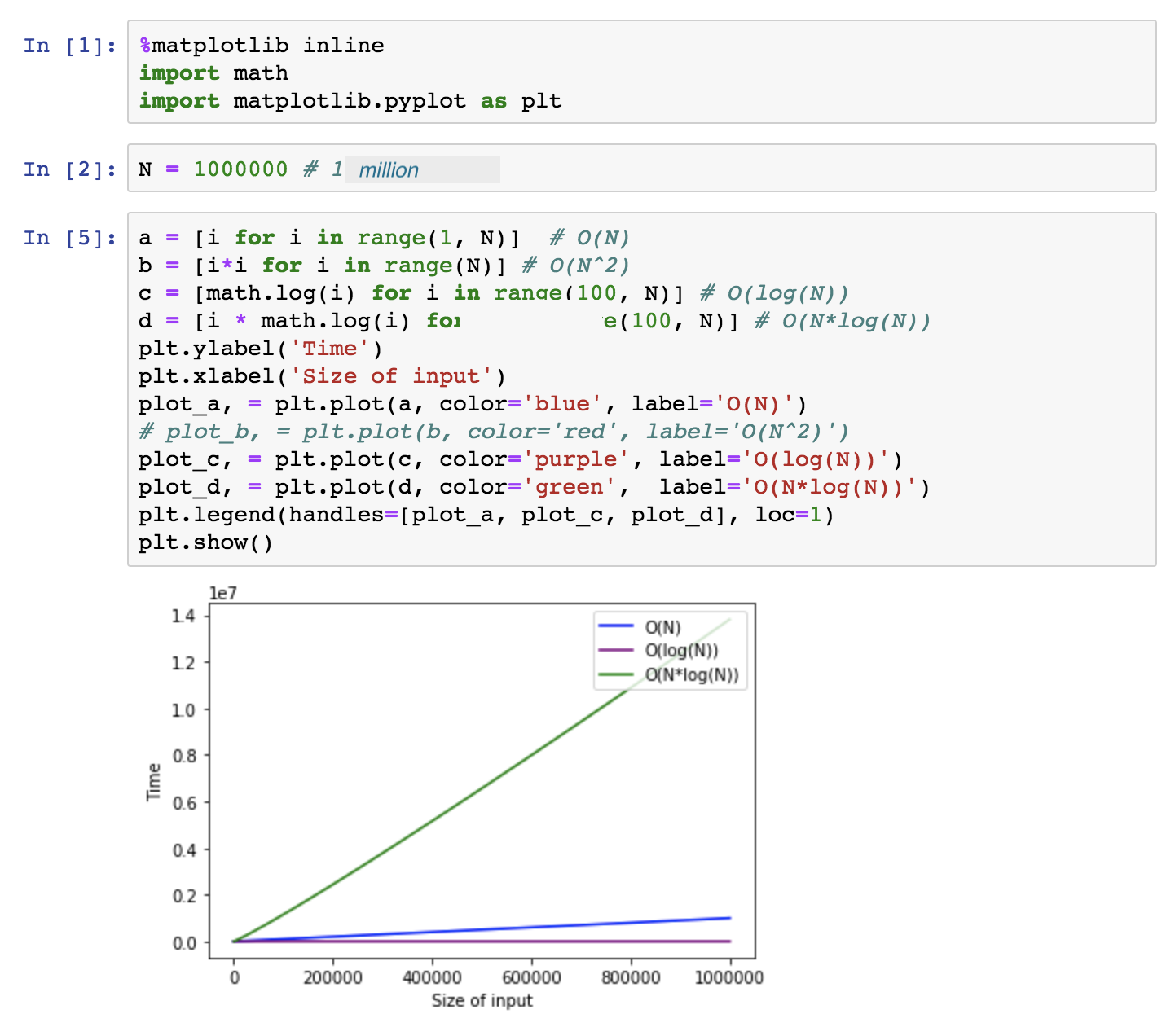Programming Challenges - Week 5 - Review Competition Problems and Intro to Data Structure
Review problems
- Homework (Hackeerank)

Practice blogging
- Create a new blog
- Review Markdown
- Add image
Data Structure and Algorithms
Big O Notation
The Big O (pronounced ‘Oh’) notation is used to classify algorithms according to how its running time or space requirements grow as the input size grows (very big, like millions and billions).
Let’s try a Jupyter notebook. Here are key operations:
- Press
Shift + Enterto execute a cell.
Loading a matplot libary
Add the following code in the Jupyter notebook, and press Shift + Enter.
%matplotlib inline
import math
import matplotlib.pyplot as plt
Add the following code on the second cell and press Shift + Enter.
N = 1000000 # 1 million
Add the rest of the code and the third cell and press Shift + Enter.
a = [i for i in range(1, N)] # O(N)
b = [i*i for i in range(N)] # O(N^2)
c = [math.log(i) for i in range(100, N)] # O(log(N))
d = [i * math.log(i) for i in range(100, N)] # O(N*log(N))
plt.ylabel('Time')
plt.xlabel('Size of input')
plot_a, = plt.plot(a, color='blue', label='O(N)')
plot_b, = plt.plot(b, color='red', label='O(N^2)')
plot_c, = plt.plot(c, color='purple', label='O(log(N))')
plot_d, = plt.plot(d, color='green', label='O(N*log(N))')
plt.legend(handles=[plot_a, plot_b, plot_c, plot_d], loc=1)
plt.show()
Here are the results. The higher the time (y-axis), the slower the runtime is.


Data Structure
- Primitive Types
- Array
- Linked List
- Hash Table (Dictionary)
- Stack and Queue
- Tree
- Heap
- Graph

Data Structure: Linked List
Contiguous vs. Linked Data Structures
- Contiguously allocated structures: arrays, heaps, and hash tables
- Linked data structures: lists, trees, and graph adjacency lists
class Node:
"""
Node for Linked List
"""
def __init__(self, data: int):
self.data = data
self.next = None
head = Node(1)
assert head.data == 1
Linked List: Insert
def insert(node, data: int):
"""
Insertion at the beginning to avoid
traversing the list
"""
tmp = Node(data)
tmp.next = node
node = tmp
return node
head = Node(1)
assert head.data == 1
head = insert(head, 2)
assert head.data == 2
assert head.next.data == 1
Linked List: Find
There are two ways to implement the find method – recursively or iteratively. In either case,
it takes O(N) time to find an item in a linked list.
# Recursive find
def find_recursive(node, data):
"""
Recursively traverse the list and
return a node when its data mathes a provided data
"""
if node is None:
return
if node.data == data:
return node
return find_recursive(node.next, data)
def find(head, data):
"""
Find a node iteratively for a provided data
"""
tmp = head
while tmp:
if tmp.data == data:
break
tmp = tmp.next
return tmp
head = Node(1)
assert head.data == 1
head = insert(head, 2)
assert head.data == 2
assert head.next.data == 1
head = insert(head, 3)
print_list(head)
assert find(head, 7) == None
assert find(head, 3) == head
assert find(head, 2) == head.next
Linked List: Delete
Deletion is more complicated than other operations. First, we need to find a pointer to the predecessor of the item to be deleted.
def find_predecessor(node, data):
"""
Find a predecessor of a node of which data matches a provided data
"""
if node is None or node.next is None:
return
if node.next.data == data:
return node
else:
return find_predecessor(node.next, data)
We needed the predecessor so that its next pointer must be changed.
def delete(head, data):
"""
Deleting a node requires a pointer to a predecessor
"""
cur = find_recursive(head, data)
if cur:
pred = find_predecessor(head, data)
if pred is None:
head = cur.next
else:
pred.next = cur.next
return head
Linked List: Print all nodes
def print_list(node):
"""
Recursively traverse the list and
print data
"""
if node is None:
return
print(node.data, end=' ')
print_list(node.next)
Putting all together
Here is the code for the above operations of a linked list.
Practice
- Write a function return the length of a linked list.
def length_of_list(head): pass - Write a function to determin if a linked list contains a duplicate value
def has_duplicate(head): pass
Summary
We learned the basic concept of Big O notation, and studied the characteristics of different running time using Jupyter Notebook (which is way cool!).
Linked List is a our first step to learn a linked data structure that is different from a contiguous data structure such as an array. The concept and techniques learend in Linked List are the building blocks for other data structure such as lists, trees and graphs.